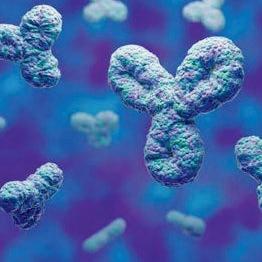Interview
Duncan Lugton, Head of Policy and Impact at IChemE (UK), on scale-up investments in Engineering Biology


Duncan Lugton, Head of Policy and Impact at IChemE (UK), on scale-up investments in Engineering Biology



With the new MALDI-8030 EasyCare you can do routine maintenance yourself. The compact instrument is easy to clean and quickly back in use again. Adding its outstanding performance parameters, it’s the ideal solution for high sample throughput, especially in a clinical environment.
Self-service maintenance
Less maintenance costs, increased uptime
Compact benchtop design
Allows installation almost anywhere in the lab
Outstanding performance
Offers comparable performance parameters to larger and more expensive MALDI-TOF instruments
www.shimadzu.eu/

A true multi-talent
Enables a wide range of applications, e.g. protein and polymer analysis or quality control for (bio)-pharmaceuticals
Available as linear positive MALDI-8020 EasyCare

SOFIE CARSTEN NIELSEN is the Director of the European Biosolutions Coalition and of the biosolutions industry community in Danish Industry since May 2023. She is a former political party leader and former Minister of Higher Education and Research, and was a member of the Danish Parliament for more than 10 years. She is a political scientist by education and has a Master’s in European Politics and Administration from the College of Europe, Bruges.
As the global race for biosolutions intensifies, Europe is at a critical crossroads, and I am deeply concerned about the future of our continent’s biotech industry. While countries like China and the United States rapidly advance their biotech industries, Europe’s slow and not up-to-date regulatory system poses a significant risk to maintaining our leadership. With recent global events and tariffs shaking global trade, immediate action is required to ensure our bio-companies thrive. We need a bold and broad EU Biotech Act to boost competitiveness, accelerate the green transition, and enhance European self-reliance.
Biotechnological solutions – we call them biosolutions – can meet global needs by boosting food production and enabling sustainable industrial processes. A McKinsey report highlights that advanced biotechnology could generate up to US$1trillion in global economic value over the next 15 years. The biosolutions industry supports over 700,000 jobs in Europe, strengthening sustainable supply chains and a circular economy.
However, biosolutions in Europe face fragmented regulatory regimes that hinder companies from scaling efficiently. They lack funding opportunities and encounter lengthy approval processes, which dishearten many firms. Addressing regulatory inefficiencies and enhancing strategic investments is necessary to secure our competitive edge – and there is no time to waste.
Three critical areas need immediate attention to help Europe’s biotech sector thrive:
1. Our regulatory processes are the slowest worldwide, adhering to outdated legislation, impairing our competitiveness. Reforming these frameworks is crucial to unleashing Europe’s innovative potential.
2. Second, strategic investment is vital to scaling biosolutions beyond pharmaceuticals. Investing in biomaterials can lead to groundbreaking products like biodegradable silk. We must ensure financing is accessible and avoid barriers that hinder investments.
3. Third, prioritising biosolutions within EU industrial policy will accelerate the shift to a bio-based economy and position Europe as a leader in sustainability. Advanced biotechnology can generate significant economic value, reduce CO2 emissions, and save water.
The need for action is undeniable. To solidify our role as a global leader in sustainability and innovation, Europe must embrace biosolutions by speeding up registration processes, ensuring accessible finance and infrastructure, and prioritising biosolutions in our industrial strategy. We must urge the European Commission, the European Parliament, and the EU Council to enact a bold and broad European Biotech Act to champion biosolutions as the cornerstone of our competitiveness and green transition. Let setbacks become comebacks and seize this opportunity to lead the biorevolution for a sustainable future in Europe. ■

Many industrial biotech projects compete directly with established and optimised petrochemical processes, and most struggle to be as efficient on cost. Big outlays for new production plants can make price parity for greener processes a distant dream, choking off industry investment and further support from policymakers. Now a publicly funded French-German-Belgian initiative is showing how petroleum-based industrial advantages can shrink once a bioeconomy facility is up and running.
8 EC to speed up technology transfer in the EU by introducing a start-up and scale-up strategy
10 EMA to simplify EU market authorisation rules for biosimilars
12 Industry protests against Counciladopted EU pharma package
18 Analyst commentary
19 European Biotech Stocks
22 Update on clinical trials
25 Closing the gaps in quality management
28 Startup: ions.Bio
40 Focus: Techparks/Bioengineering
41 Bayer Berlin develops a Life Sciences Campus
43 Interview: Duncan Lugton, Head of Policy & Impact, IChemE, UK
46 It’s time to rethink biotech scaling
47 Unlocking Pichia for industry
48 Interview: Jeffrey Truong, Helmholtz Munich, Germany
50 Ensuring flexibility and resilience
52 Why life sciences leaders need more than science
60 Northern Europe: Sweden, Denmark, Norway and Finland
62 Western Europe: France, Belgium, The Netherlands and the UK
64 Central Europe: Germany, Switzerland and Austria
66 Southern Europe: Italy, Spain, and Portugal
68 Spanish biotech – its growth, impact and global role
69 Eastern Europe: Poland, Lithuania and the Czech Republic
FOCUS NEW MODALITIES
70 SLAS Europe 2025 in Hamburg: Innovation in lab automation tools drive discovery of new modalities
72 ThirdLaw Molecular: Spiroligomers –not antibodies, not small molecules
73 MabSwitch: Antibodies with allosteric ON/OFF switch
53 Biopeople
74 Science & Technology
76 News from associations
80 Company index
81 Events
82 Encore
IMPRINT European Biotechnology (ISSN 2364-2351) is published quarterly by: BIOCOM Interrelations GmbH, Jacobsenweg 61, D-13509 Berlin, Germany, Tel.: +49-30-264921-0, Fax: +49-30-264921-11, Email: service@european-biotechnology.com, Internet: www.european-biotechnology.com; Publisher: Andreas Mietzsch; Editorial Team: Thomas Gabrielczyk (Editor in Chief), Derrick Williams (Co-editor), Dr. Georg Kääb, Uta Mommert, Maren Kühr, Advertising: Oliver Schnell, +49-30-264921-45, Christian Böhm, +49-30-264921-49, Andreas Macht, +49-30-264921-54; Distribution: Nancy Weinert +4930-264921-40; Graphic Design: Michaela Reblin; Production: Martina Willnow; Printed at: Königsdruck, Berlin; European Biotechnology Life Sciences & Industry Magazine is only regularly available through subscription with a BIOCOM CARD. Annual subscription BIOCOM CARD Europe: €80 for private individuals (students €40) incl. VAT, €120 plus VAT for corporates. Prices includes postage & packaging. Ordered subscriptions can be cancelled within two weeks directly at BIOCOM AG. The subscription is initially valid for one calendar year and is automatically renewed every year after. The subscription can be cancelled at any time and is valid until the end of that calendar month. Failures of delivery, which BIOCOM AG is not responsible for, do not entitle the subscriber to delivery or reimbursement of pre-paid fees. Seat of court is Berlin, Germany. As regards contents: individually named articles are published within the sole responsibility of their respective authors. All material published is protected by copyright. No article or part thereof may be reproduced in any way or processed, copied, and proliferated by electronic means without the prior written consent of the publisher. This issue contains a supplement of mts med-tech supplies GmbH, Cover Photo: © G.Go - stock.adobe.com; ® BIOCOM is a registered trademark of BIOCOM AG, Berlin, Germany.
“Uncertainty” is the word most often used to describe President Donald Trump’s approach to trade, science and pharmaceutical pricing policy. His strategy seems to be to shock first and negotiate later – even with arch-rival China, which is challenging the United States’ decadeslong dominance in most biotech fields. Europ E an Biot E chnology takes a closer look at the situation as of June 2025.


Although ongoing trade disputes and protectionist policies dominate the headlines, regions and industry leaders that recognise the potential of bioengineering are already preparing for the future. EuropE an BiotEchnology spotlights emerging open innovation clusters and cutting-edge bioengineering platforms.
Science is not flawless. It’s a deeply human endeavour that’s often slow to accept breakthroughs. Just consider the HPV cancer vaccine, which took two decades to gain mainstream recognition. Prestige often goes to the well-connected, measured more by h-index than by true innovation. Yet one thing will never change: science depends on international cooperation. This cooperation doesn’t arise due to personal rapport. It’s born of necessity. Only by working together can we develop cures for untreatable diseases, build waste-free industries, secure food supplies despite threats like avian flu, or construct engines powered by CO2 and saltwater. These ideas and others are not dreams. They’re the foundation of a sustainable, competitive economy. Today, that foundation is cracking. The current US administration is undermining global science by banning foreign talent, replacing experts at the FDA and CDC with loyalists, promoting protectionism, and slashing NIH, NASA and NSF funding. These moves threaten to stall biomedical progress –and hand scientific leadership to authoritarian regimes like China.
The US is still a scientific powerhouse. But isolationism weakens global innovation. The democratic world must recover from its shock and act with unity, resolve and a renewed dedication to working together: Make Collaboration Great Again.

Thomas Gabrielczyk Editor-in-Chief


BIOECONOMY Many industrial biotech projects compete directly with traditional petro-based production processes. And many that start out in publicly funded industrial biotechnology start-up ecosystems in Europe fail because they’re simply not at first competitive when it comes to costs. The petrochemicals industry has had decades to optimise both production processes and return on investment in existing plants. Now a French-German-Belgian project is showing how those advantages dwindle when a bioeconomy plant is up and running.
To reach the goals set out in Europe’s Clean Industrial Deal, it will be essential to rapidly transform energy-intensive, fossil-based industries. So to kick things off, let’s take a look at the deal’s objectives and do a quick reality check.
Biotechnology has emerged as the central technology platform capable of supporting the planned transition. It offers a wide range of tools for doing so, among them energy-efficient biocatalysts for the chemical sector, climate-friendly production of food and animal feed proteins, microbial recovery of rare critical materials, manufacturing of pharmaceutically active substances and many others. These applications are closely aligned with objectives laid out in the EU Bioeconomy Strategy (2020). These include achieving food security, promoting the sustainable use of natural resources, reducing dependence on fossil inputs, mitigating climate change, and contributing to economic competitiveness and job creation within the European Union.
Despite its big ideas and huge potential, however, the EU has often lagged behind in the global race to ‘biologise’ industrial processes. Countries with more aggressive strategies like the US, China, Singapore and Brazil are more often viewed as benchmark setters. China for instance has invested heavily in fermentation capacity. Singapore is expediting regulatory approval for novel foods. Brazil is advancing with a clearly defined bioeconomy roadmap. The new government in the US, on the other hand, seems to have slammed the brakes on what largescale biomanufacturing has achieved there so far (s. page 54). Might that mean opportunities for Europe?
One of the biggest barriers to reaching clean industry goals within the EU is the high capital expenditure (CAPEX) associated with building demonstration or production facilities. Many biotech processes could be competitive with petrochemical alternatives in terms of operating costs. But when major new
infrastructure investments are required to get things up and running, that doesn’t mean much. Many a promising business model has struggled to survive the Valley of Death between innovation and industrial implementation. Many don’t.
The Circular Bio-based Europe Joint Undertaking (CBE JU) was set up to help more of these projects get the support they need. It’s a €2bn partnership between the European Union and the Biobased Industries Consortium (BIC) that funds projects advancing competitive circular bio-based industries in Europe. The partnership seeks to build on the success of its predecessor, the Bio-based Industries Joint Undertaking (BBI JU) while addressing the current challenges facing the industry. To reach clean industry goals and hit ambitious climate targets by shifting away from non-renewable fossil raw materials and minerals, the EU will have to strengthen its resource independence and support sustainable economic growth.
The stated role of CBE JU is to bring together various groups – ranging from farmers to scientists to large bio-based industries – to solve the technological, regulatory and market challenges facing the sector. Its public-private funding scheme is supposed to boost innovation and market deployment, and pave the way for future investment.
...but industry has to step in
There are many EU-funded projects in circularity and biobased industries. A short list from the field of biomass utilisation alone reveals a very wide range in the field:
› Rural BioReFarmeries: Develops small-scale, decentralised green biorefineries to enhance farmer sustainability and competitiveness. Funding: €7.35m. Coordinator: Munster Technological University, Ireland.
applications. Funding: €4m. Coordinator: University of Bologna, Italy.
› LUCRA: Demonstrating sustainable production of bio-succinic acid from organic waste using integrated electrochemical bioreactors. Coordinator: Bio Base Europe Pilot Plant, Belgium.
› NewWave: Develops sustainable, biobased manufacturing lines by converting biomass residues into valuable products. Funding: €8.5m.
› Bio-LUSH: Valorises underutilised European plant resources like forest residues or marine plants to produce high-quality fibres for sustainable products. Coordinator: Stockholm University, Sweden. When it comes to nuts and bolts, the BBI JU/CBE JU-funded AFTERBIOCHEM project is one of the very few projects that has managed to actually build a flagship biorefinery, now up and running in Carling Saint-Avold (France). There, sugar industry by-products and other non-food agricultural biomass are turned into seven high-added-value bio-based organic acids for fragrances and flavourings, personal care, food and feed, industrial chemicals and a potassium-rich fertiliser. Accounting for around half of global production, the EU is the world’s largest producer of sugar beets. The crop is important to Europe’s economy, but prices for beet-derived sugar have fallen, so the sector is being forced to capitalise on every potential income source. The industry supports 140,000 farmers in the bloc, as well as around 27,000 direct jobs in processing and further upstream employment. Until 2017, sugar-beet production in Europe was shored up by a quota system. However, since this system was scrapped, its end and other factors have led to a 30% fall in sugar prices. EU sugar-beet producers have responded by increasing production. But against a backdrop of worldwide overproduction of the commodity, that move has only increased price pressures.
Being competitive is key
AFTERBIOCHEM brought together 12 partners at different stages of the value chain: four SMEs, seven large companies
› ONE EARTH: Establishing a circular bioeconomy by valorising residual animal biomass for terrestrial and marine ›› Read the full story in the printed issue

In addition to implementing a 40% budget cut at the US Department of Health & Human Services in 2026, the Trump administration plans to eliminate all funding previously allocated by the Biden administration for industrial biotech expansion. However, in a move that has received little public attention, the administration is also quietly advancing sustainable industrial biotech production through the multibillion-dollar budget at the NSCEB (https://t1p.de/r4erg).
BIOTECH GEOPOLITICS The threat of high import tariffs and government-enforced price cuts in the world’s leading pharmaceutical market, the US, are beginning to have an impact on the global biopharmaceuticals sector. What exact geopolitical consequences the dismantling of US research funding and mass layoffs in regulatory, epidemic, and climate protection agencies will have remains to be seen. But the existing biotech world order is faltering and changing in unforeseen ways. Who stands to benefit?
Donald Trump entered his second term of office on January 20, but by mid-June most of the threats made by the US President still had yet to be fully implemented. Nor had his regime’s drastic cuts to the country’s research budget been upheld in court. But if announced plans for import tariffs, pharmaceutical price reductions, and cuts to research freedom really do go into full force, they could do serious damage to the fields of biomedicine and industrial biotechnology internationally.
The mere fact that 80% of planned NIH research funding has not been disbursed since February 2025 and 40% of the NIH budget plus 50% of the National Science Foundation (NSF) budget is to be cut in 2026 has been enough to incite panic in the biopharmaceutical ecosystem. NIH funding alone exceeds the R&D budget of the largest industry sponsors of clinical trials: 99% of the drugs approved by the FDA between 2010-2019 can be traced back to NIHfunded research (10.1001/jamahealthforum.2023.1921). Of the NIH’s annual US$47bn budget, US$18bn is used to fund international clinical trials in which US groups are involved.
Research and industry partners are suffering, of course, but also clinical service providers (CROs) and contract manufacturers (CDMOs). “Severe cuts to US re -
search funding, combined with deep uncertainty caused by unpredictable policies on tariffs and drug pricing, have led to significant investor hesitation in biotechnology and clinical research,” says Martin Krauss, President of the CRO association BVMA and CEO of FGK GmbH. “This is critically slowing the development of new therapies. Beyond the economic damage to innovation-driven industries, the longterm consequence will be fewer treatment options for patients,” he fears. “This troubling trend must be urgently addressed and reversed. At the same time, it presents a strategic opportunity for Europe to position biotechnology as a key sector and to strengthen the political and regulatory framework to attract increased investment and use its excellent basic research.“
products acquired through international M&A, agreements or joint ventures. Since 2023, cancer-related deals with Chinese biotech companies have taken centre stage. There and in other areas the impact of the new geopolitical approach that’s being nurtured by the White House – geared toward national interests – is already being felt. For May 2025, investment bank Jefferies reported a 57% decline in biotech financing (to US$2.7bn) compared to the same period last year. That followed an April that marked the worst figures since 2021. EY also reports record investment last year, along with its abrupt end in the first quarter of 2025. Jefferies analyst David Windley blames mass layoffs at the FDA, budget cuts at the NIH, and unclear statements from the White House about the structure of US drug prices. “Biotechs want clarity on FDA regulation, funding and drug pricing before committing to large investments,” Windley comments.
The US President is not taking a very systematic approach to his key objectives. To achieve his stated goal of bringing production back to the US, for example, he initially threatened to impose import tariffs on biopharmaceuticals, services and raw materials, that have now been suspended until the beginning of July due
There’s no question that the 157 executive orders issued during Trump’s first five months in office – just five fewer than Joe Biden signed in his entire term – are unsettling biopharmaceutical investors worldwide. Because they bear the hallmarks of protectionism and hostility to multilateralism, the biopharmaceutical financial engine that is fueled by international deals is sputtering. According to the EY Firepower Report, Big Pharma generates around 65% of its revenue from ›› Read the full story in the printed issue.
21st. BIO (DK) 65
A
ABB Ltd (CH) 53
Abundance Gate (AT) 65
ADC Therapeutics (CH) 64
Afyren (F) 16, 82
Agilent Technologies (USA) 53
Alchemab Therapeutics (GB). . . . . . . . . . . 62
Alvotech SA (ISL) 60
Amplifybio LLC (USA) 82
Amsilk GmbH (DE) 65
Aphea.Bio NV (BE) 82
ASEBIO | BIOSPAIN 2025 (ES) 30, 31, 68
Astoriom (GB)...................... 53
Astraveus SAS (F) 63
AstraZeneca AB (SE/UK) 70
Augustine Therapeutics NV (BE) 24
Avecom NV (NL) 61
Axxam SpA (IT) 65
Azafaros BV (BE) 63
Azenta Life Sciences (USA) 53
B Bayer Co.Lab Berlin (DE) 13, 41
BioGeneration Ventures (NL) 63
BioNTech SE (DE) 63, 64, 82
BIOTECH AUSTRIA | BIOTECH Summit 34, 35
Boehringer Ingelheim (DE) 24, 50, CP4
Bristol Myers Squibb (USA) 63, 64
Brooks Life Sciences (USA) ............ 53
Byondis BV (NL) 22
C
Captain T Cell GmbH (DE) 41
Celanese (NL) ...................... 16
Clean Biologics Group (F) 53
Concept Heidelberg |
PharmaLabCongress 2025 (DE) 38, 39
Curevac N.V. (DE) 63, 64
Curie.bio (AT) 65
Cytovation ASA (NO) ............. 24, 61
D Danaher Group (USA) 53
Danish Centre for AI Innovation 60
DASGIP an Eppendorf Company (DE) .... 11
Dr. Reddy's Laboratories Ltd. (IND) 60
E
EBD Group | BIO-Europe 2025 (CH) 36, 37
Eli Lilly & Co Ltd (USA) ........... 62, 63
Elicit Plant (F) 82
ELRIG | Drug Discovery 2025 (GB) 32, 33
ERBC (F) 67
European Biotechnology Network (DE) 23
Export and Investment Fund of Denmark 61
F
Ferrer Internacional (ES) 66
FGK Clinical Research GmbH (DE) 27, 55
Fiabila (F) 16
Fördergesellschaft IZB (DE) ......... 23, 28
Forbion Capital Partners (NL) 63
G
GEA New Food (DE) 57, 58 Green Alchemy ApS (DK) 61
H
H. Lundbeck A/S (DK) 60
HealthCap IX (SE) 61
Heidelberg Pharma AG (DE) 24
Heura Foods (ES) 82
HutanBio Ltd. (GB) 45
I IBA Lifesciences GmbH (DE) 47
Iksuda Therapeutics Ltd. (GB) 24
Illumina Inc. (USA) 74
Immunic Therapeutics AG (DE) ...... 18, 22
Inflarx NV (DE) 24
InstaDeep (GB) 63
Institution of Chemical Engineers (GB) 43 ions.bio (DE) 28
Iron Wolf Captial (LT) 69
J/K
Jeito Capital (F) 63 KelpEat srl. (IT) 67
Kemin (BE) 16
Keysight Technologies (USA) ........... 53
Körber AG (DE) 53
Kurma Partners (F) 67
L/M
Landmark Bioventures AG (CH) 62
Lifeline Ventures (FI) 60
Mabswitch Inc. (USA) 73
Marinomed Biotechnologie GmbH (AT) 65
Massalia Therapeutics SA (F) 62
Menarini Biotech S.r.l. (IT) 67
Merck & Co (USA) 64
Millow AB (SE) 61
Molecular Devices Ltd. (USA) 53 Molecular Health (USA) .............. 65
Molecular Partners AG (CH) 64
MoonLake Therapeutics (CH) 64
mts med-tech supplies (DE) 45, Supplement
MyoPax ApS (DK) 41
MyxoTech GmbH (DE) 25
NEC Corp. (JP)
Richter BioLogics GmbH (DE) CP3 Roche AG (CH) ............... 22, 55, 74 Ryvu Therapeutics zoo (PL) 69
Schroder Investment S.A. (DE) ......... 63 Seroba Life Sciences (IRL) 63 Shimadzu Europa GmbH (DE) CP2 SLAS Society of Laboratory Automation and Screening (USA) 70-72, 77
Industries Inc Oy (FI) 60
Tenthpin Solutions AG (CH) 9, 25-27
ThirdLaw Molecular (USA) 70, 72
TILT Biotherapeutics Ltd. (FI) 60 TIRmed Pharma (SE) .............. 53, 61 Tolremo Therapeutics AG (CH) 22
SA (F) 22
(AT)
Laboratory Solutions Ltd. (GB) 71
Wirtschaftsuniversität Wien (AT) 52, 59





YOUR PRODUCT — OUR COMPETENCE AND DEDICATION FOR MORE THAN 35 YEARS!
RichterBiologicsisyourprofessionaland experiencedpartnerofferingCDMOsolutions fromgenetoproductallfromonesource.
RichterBiologics:expertforlatestage andcommercialproduction.





RICHTERBIOLOGICS
Suhrenkamp59,22335Hamburg,Germany
Phone:+494055290-801
BusinessDevelopment@richterbiologics.eu





CONTACT US TO BRING YOUR PROJECT TO SUCCESS!






